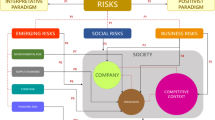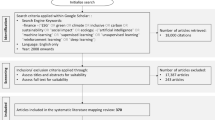Abstract
Access to government funding is one of the most effective ways to enhance the resilience for small- and medium-sized enterprises (SME) community after a disaster. Along these lines, a major focus of SME resiliency research has been on examining factors needed to keep an SME open after a disaster. This makes sense as SMEs are critical to community recovery. It seems logical that the severity of a disaster would indicate the impact to a community. Using a systems thinking methodology, we developed a hypothesis that this correlation of severity to impact breaks down over time, causing the community to quickly spiral into trouble. This paper presents an agent-based model to test our hypothesis. The results indicate the impact to a community becomes much more extreme after a threshold or “tipping point” is crossed.








Similar content being viewed by others
Notes
Community is defined a population of less than 10,000 people.
The terms ‘business’ and ‘enterprise’ are used interchangeably and a SME is defined as having less than 500 employees.
References
Alecsh DJ, Holly JN, Mittler E, Nagy R (2001) Organizations at risk: what happens when small businesses and non-for-profits encounter natural disasters. Public Entity Risk Institute, Fairfax
Alesch DJ, Holly JN (1996) How to survive the next natural disaster: lessons for small business from Northridge victims and survivors. In: Proceedings of Pan Pacific hazards conference, Disaster Preparedness Resource Center, University of British Columbia, Vancouver, British Columbia
Alshehri SA, Rezgui Y, Li H (2015a) Disaster community resilience assessment method: a consensus-based Delphi and AHP approach. Nat Hazards 78:395–416. doi:10.1007/s11069-015-1719-5
Alshehri SA, Rezgui Y, Li H (2015b) Delphi-based consensus study into a framework of community resilience to disaster. Nat Hazards 75:2221–2245. doi:10.1007/s11069-014-1423-x
Baldwin WC, Ben-Zvi T, Sauser BJ (2012) Formation of collaborative system of systems through belonging choice mechanisms. IEEE Trans Syst Man Cybern Part Syst Hum 42:793–801. doi:10.1109/TSMCA.2011.2164522
Baldwin C, Boardman J, Sauser B (2013) Expanding a system of systems model with the schelling segregation model. Syst Res Behav Sci 30:65–75. doi:10.1002/sres.2115
Beck T, Demirguc-Kunt A (2006) Small and medium-size enterprises: access to finance as a growth constraint. J Bank Finance 30:2931–2943. doi:10.1016/j.jbankfin.2006.05.009
Boardman J, Sauser B (2006) System of systems—the meaning of of. In: Proceedings of the 2006 IEEE/SMC international conference on system of systems engineering. IEEE, Los Angeles, CA, pp 118–123
Bourque LB, Shoaf KI, Nguyen LH (1997) Survey research. Int J Mass Emerg Disasters 15:71–101
Brock WA, Evans DS (1989) Small business economics. Small Bus Econ 1:7–20
Brown D, Kulig J (1996) The concept of resiliency: theoretical lessons from community research. Health Can Soc 4:29–52
Chang SE, Yip JZK, van Zijll de Jong SL et al (2015) Using vulnerability indicators to develop resilience networks: a similarity approach. Nat Hazards 78:1827–1841. doi:10.1007/s11069-015-1803-x
Cutter S (2008) A framework for measuring coastal hazard resilience in new jersey communities. White paper for the Urban Coast Institute. Accessed 08 Aug 2017. //co.monmouth.nj.us/documents/104/CoastalHazardResilientCommunities.pdf
Dahlhamer JM, Tierney KJ (1996) Winners and losers: predicting business disaster recovery outcomes following the Northridge earthquake. Univesity of Delaware, Disaster Research Center, Newark
Dahlhamer J, Tierney K (1998) Rebounding from disruptive events: firm recovery following the Northridge earthquake. Sociol Spectr 18:121–141
Dawson RJ, Peppe R, Wang M (2011) An agent-based model for risk-based flood incident management. Nat Hazards 59:167–189. doi:10.1007/s11069-011-9745-4
Doern R (2014) Entrepreneurship and crisis management: the experiences of small businesses during the London 2011 riots. Int Small Bus J. doi:10.1177/0266242614553863
Durkin ME (1984) The economic recovery of small businesses after earthquakes: the Coalinga experience. In: International conference on natural hazards mitigation research and practice, Vigyan Bhavan, New Delhi
Edvardsson IR, Teitsdóttir UD (2015) Outsourcing and financial crisis: evidence from Icelandic service SMEs. Empl Relat 37:30–47. doi:10.1108/ER-11-2013-0168
Evers PT, Wan X (2012) Systems analysis using simulation. J Bus Logist 33:80–89. doi:10.1111/j.0000-0000.2012.01041.x
Fiksel J (2003) Designing resilient, sustainable systems. Environ Sci Technol 37:5330–5339
Fullilove M, Saul J (2006) Rebuilding communities postdisaster in New York. In: Neria Y, Gross R, Susser E (eds) 9/11: mental health in the wake of terrorist attacks. Cambridge University Press, Cambridge, pp 164–177
Gallopin GC (2006) Linkages between vulnerability, resilience, and adaptive capacity. Glob Environ Change 16:293–303
Goble G, Fields H, Cocchiara R (2002) Resilient infrastructure: improving your business resilience. IBM Global Services, Armonk
Godschalk DR (2003) Urban hazard mitigation: creating resilient cities. Nat Hazards Rev 4:136–143
Grimm V, Railsback S (2006) Agent-based models in ecology: patterns and alternative theories of adaptive behaviour. In: Billari FC, Fent T, Prskawetz A, Scheffran J (eds) Agent-based computational modelling. Physica-Verlag, Heidelberg, pp 139–152
Grimm V, Berger U, Bastiansen F et al (2006) A standard protocol for describing individual-based and agent-based models. Ecol Model 198:115–126. doi:10.1016/j.ecolmodel.2006.04.023
Grimm V, Berger U, DeAngelis DL et al (2010) The ODD protocol: a review and first update. Ecol Model 221:2760–2768. doi:10.1016/j.ecolmodel.2010.08.019
Gunasekaran A, Rai BK, Griffin M (2011) Resilience and competitiveness of small and medium size enterprises: an empirical research. Int J Prod Res 49:5489–5509
Hamel G, Välikangas L (2003) The quest for resilience. Harv Bus Rev 81:52–63
Hansen B, Hamilton RT (2011) Factors distinguishing small firm growers and non-growers. Int Small Bus J 29:278–294. doi:10.1177/0266242610381846
Hashemi M, Alesheikh AA (2013) GIS: agent-based modeling and evaluation of an earthquake-stricken area with a case study in Tehran, Iran. Nat Hazards 69:1895–1917. doi:10.1007/s11069-013-0784-x
Kim YA, Akbar H, Tzokas N, Al-Dajani H (2014) Systems thinking and absorptive capacity in high-tech small and medium-sized enterprises from South Korea. Int Small Bus J 32:876–896. doi:10.1177/0266242613483632
Kroll CA, Landis JD, Shen Q, Stryker S (1991) Economic impact of the Loma Prieta earthquake: a focus on small business. University of California, Transportation Center and Center for Real Estate and Economics, Berkeley
Little RG (2002) Toward more robust infrastructure: observations on improving the resilience and reliability of critical systems. In: 36th Hawaii international conference on system sciences, Honolulu
Manuj I, Mentzer JT, Bowers MR (2009) Improving the rigor of discrete-event simulation in logistics and supply chain research. Int J Phys Distrib Logist Manag 39:172–201. doi:10.1108/09600030910951692
McClure DL (2000) Disaster recovery for small businesses. Cent US Earthq Consort J 7:10
Nejat A, Damnjanovic I (2012) Agent-based modeling of behavioral housing recovery following disasters. Comput Aided Civ Infrastruct Eng 27:748–763. doi:10.1111/j.1467-8667.2012.00787.x
Norris FH, Stevens SP, Pfefferbaum B et al (2008) Community resilience as a metaphor, theory, set of capacities, and strategy for disaster readiness. Am J Community Psychol 41:127–150
Pfefferbaum B, Reissman D, Pfefferbaum R et al (eds) (2005) Building resilience to mass trauma events. Kluwer, New York
R Core Team (2015) R: a language and environment for statistical computing. R Foundation for Statistical Computing, Vienna
Randall WS, Farris MT II (2009) Supply chain financing: using cash-to-cash variables to strengthen the supply chain. Int J Phys Distrib Logist Manag 39:669–689. doi:10.1108/09600030910996314
Rice J, Caniato F (2003) Building a secure and resilient supply network. Supply Chain Manag Rev 7:22–30
Rose A (2004) Defining and measuring economic resilience to disasters. Disaster Prev Manag 13:307–314
Rose A (2005) Analyzing terrorist threats to the economy: a computable general equilibrium approach. In: Gordon P, Richardson H (eds) Economic impacts of terrorist attacks. Edward Elgar, Cheltenham, pp 196–217
Rose A (2007) Economic resilience to natural and man-made disasters: multidisciplinary origins and contextual dimensions. Environ Hazards 7:383–398
Rose A, Liao S (2003) Understanding sources of economic resiliency to hazards: modeling the behavior of lifeline service customers. In: Engineering TMC for E (ed) Research progress and accomplishments. Cambridge University Press, Cambridge, pp 149–159
Rose A, Oladosu G, Liao S-Y (2005) Regional economic impacts of terrorist attacks on the electric power system of Los Angeles: a computable general disequilibrium analysis. In: Second annual symposium of the DHS Center for risk and economic analysis of terrorism events, USC, Los Angeles
Sauser B, Mansouri M, Omer M (2011) Using systemigrams in problem definition: a case study in maritime resilience for homeland security. J Homel Secur Emerg Manag 8:1–19. doi:10.2202/1547-7355.1773
Schelling T (1969) Models of segregation. Am Econ Rev 59:488–493
Schelling T (1971) Dynamic models of segregation. J Math Sociol 1:143–186
Schrank HJ, Marshall MI, Hall-Phillips A et al (2013) Small-business demise and recovery after Katrina: rate of survival and demise. Nat Hazards 65:2353–2374
Seitz J, Langan J (2015) Wells Fargo sponsors Gallup industry study to gain insight into financial needs of diverse-owned small businesses. Wells Fargo Newsroom, San Francisco
Senge P (1990) The fifth discipline: the art and practice of the learning organization. Currency Doubleday, New York
Sokolinskaya NE, Kupriyanova LM (2015) Evaluation of small business support’s effectiveness. Asian Soc Sci 11:98. doi:10.5539/ass.v11n7p98
Sperling GB, Mills KG (2012) Moving Americas small businesses and entrepreneurs forward: creating and economy built to last. National Economic Council, The White House, Washington, DC
Tumwine S, Akisimire R, Kamukama N, Mutaremwa G (2015) A borrowing cost model for effective performance of SMEs in Uganda. World J Entrep Manag Sustain Dev 11:74–89. doi:10.1108/WJEMSD-03-2014-0009
Webb G, Tierney K, Dahlhamer J (2000) Firm and disasters: empirical patterns and unanswered questions. Nat Hazards Rev 1:83–90
Webb G, Tierney K, Dahlhamer J (2002) Predicting long-term business recovery from disaster: a comparison of the Loma Prieta earthquake and Hurrican Andrew. Environ Hazards 4:45–58
Wilensky U (1997) NetLogo segregation model. Center for Connected Learning and Computer-Based Modeling. Northwestern University, Evanston
Wilensky U (1999) NetLogo. Center for Connected Learning and Computer-Based Modeling. Northwestern University, Evanston
Yoshida K, Deyle RE (2005) Determinants of small business hazard mitigation. Nat Hazards Rev 6:1–12
Zhang Y, Lindell MK, Prater CS (2007) Vulnerability of community businesses to environmental disasters. University of Illinois, Mid-America Earthquake Center, Champaign
Funding
Funding was provided by Jim McNatt Institute for Logistics Research (Grant No. JMI-101).
Author information
Authors and Affiliations
Corresponding author
Rights and permissions
About this article
Cite this article
Sauser, B., Baldwin, C., Pourreza, S. et al. Resilience of small- and medium-sized enterprises as a correlation to community impact: an agent-based modeling approach. Nat Hazards 90, 79–99 (2018). https://doi.org/10.1007/s11069-017-3034-9
Received:
Accepted:
Published:
Issue Date:
DOI: https://doi.org/10.1007/s11069-017-3034-9




